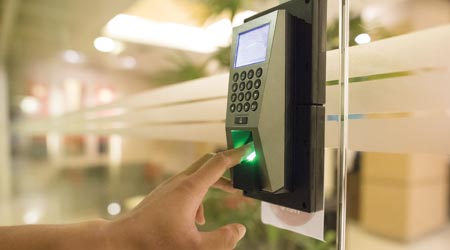Access Control: Specification Based on Facility Needs
Effective upgrades of door hardware and security technology requires understanding options and making smart specification decisions
The overall challenge for managers planning upgrades to access control and security systems is matching the available door hardware and related products to the needs of the facility.
Electricity to door hardware can be wired from remote or local low-voltage power supplies, from network cabling via power over ethernet (PoE), or by batteries. Wired systems are the easiest and lowest cost to maintain, but they have a higher construction cost.
PoE locksets with integral card readers can be the most expensive of the wired lockset options, due to the high cost of the power-transfer hinge that connects the power and data from the reader and lockset to the network.
While batteries can lower initial costs by allowing the deletion of power supplies and cabling to doors, they require replacement proportional to their use. Wireless connectivity to the battery-operated lockset also must be established using WiFi or a proprietary wireless hub system, which adds costs and complexity.
The use of smart card access, mobile credentials, and biometric readers eases facility access for users, and they provide a record of when the doors were used and by whom. Mobile credentials allow occupants to use their smartphones or other mobile smart devices to authenticate themselves to gain access.
Biometric readers allow users to enter a facility based on their fingerprints, iris patterns, and facial and voice recognition. Each biometric reader device has its own set of integration and licensing requirements that managers should fully explore. Deciding on the type of authentication desired will help managers determine the most appropriate system for installation in a particular facility or location.
Door and lock monitoring creates a record of who accessed a door and when, and managers can gather this data from door-position sensors and lock-status indicators. Not all applications require this level of detailed monitoring. Knowing the goals of the project beforehand will help ensure that the selected system is the best for the application.
Installation considerations
The key to any successful upgrade of an access control system can be summarized as, “Know what you have. Know what you want.”
Managers can select from among many types of card readers, so asking the right questions is important in making a successful selection. Is the one to be installed compatible with the credentials and control system in use at the facility? Does it have the desired features? Can it accommodate future upgrades, such as mobile credential reading? Managers should not assume it can. Make sure bid documents clearly spell out the features to be included.
Managers using wireless locksets need to confirm that the new system can integrate with the existing wireless system. This approach helps avoid the cost of replacing the current system. Managers also must be aware of the cost implications of deleting or extending wired systems before committing to a path. Door -locking devices use magnets, electric strikes or electric locks, so find out if the new system will replace the existing hardware or supplement it.
A magnetic lock will not allow traditional key-operated locks to remain. The use of magnetic locks introduces safety code complexities, including required fire alarm interfaces and override exit buttons near the door. A magnetic lock must have constant power to remain locked, so operationally, managers will need to consider the consequences of a power outage and the impact to a facility’s security posture.
Using electric strikes generally allows for the reuse of the existing door locking hardware. Installing electric locks is the most expensive option and requires extensive door and frame modification, as well as all new door hardware.
Because changeovers in systems can create gaps in coverage, managers need to ask if the new system can be brought online before it is complete. If not, they will need to decide the most effective way to address security and locking during the installation period.
A system that can operate on a piece-by-piece basis can address the need to maintain facility security during conversion. This generally requires that the old and new systems operate in parallel as devices gradually move to the new system.
Other options for this situation include requiring installation during building downtimes, providing extra security staff to monitor doors, and temporarily relocating high-security functions or contents.
Proper project scheduling during construction is essential for minimizing disruptions. Scheduling a time during which technicians can convert critical doors helps minimize disruptions to facility operations, and it keeps installation costs from escalating.
To help maintain security during the installation of the access control system, managers have a variety of options, including posting security guards, scheduling work during open access times, and requiring each door to be complete before leaving for the day.
Commissioning the new access control system is essential to ensure hardware and software are properly installed and programmed. Having a knowledgeable party review the installation and perform thorough testing can help managers identify flaws, resulting in a more reliable system.
Finally, operational and maintenance training for staff is essential for a successful project. Without it, users resort to past behaviors and misinterpret system messages. Effective training minimizes the learning curve and identifies the most efficient inspection, maintenance and troubleshooting methods.
Related Topics:














